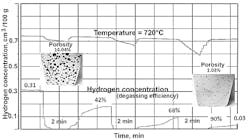Developers of new products have a soft spot for aluminum, which in the scope of history remains a relatively new and novel material. It is light, of course, which is near the top of almost any list of objectives in product design. It’s also a good conductor of heat and electricity, and yet it is widely available. On the manufacturing side of the ledger though, one issue that has yet to be fully resolved is the high cost of processing aluminum, compared to other metals and alloys that a product developer might choose.
Metallurgical researchers at England’s Brunel University London have reported that treating molten metal with ultrasound is a cleaner, more environmentally sound, and more efficient route to high quality castings. They worked with aluminum alloys at 700°C, which contain a high percentage of dissolved hydrogen. Left untreated, the resulting castings are highly porous.
The most common way to remove hydrogen from molten aluminum is argon rotary degassing, and that is one example of the energy-intensity and raw materials cost that makes processing aluminum expensive on an industrial scale.
In a pilot-scale research program funded by EU Framework Seven Programme, Prof Dmitry Eskin and a team of researchers at the Brunel Centre for Advanced Solidification Technology discovered that ultrasound was equally efficient as the standard method and yet produced far less dross. It was, therefore, a more productive and “greener” method to achieve the same result.
“We know from industry that the price of argon gas continues to rise because making it requires producers to liquefy air, which takes a lot of energy,” Prof. Eskin related. “There are also issues with the graphite impellers used. If they break in use the entire batch of alloy is contaminated and useless.
“Our pilot-scale research with quantities of up to 150 kg confirmed earlier laboratory tests that a moving ultrasound probe could achieve the similar end results, in terms of the resulting casting quality to using argon, but with the advantages of not relying on expensive and fragile graphite rods and expensive gas which cannot be captured and recycled,’ Eskin continued.
The professor reported that the volume of dross produced by the ultrasound method represented a “five-fold reduction” compared to the argon rotary degassing method. “Recovering useable metal from dross is also an expensive and energy intensive process that involves electrolysis,” he noted.
The next step for Eskin’s research team will be to scale up the trials to half-metric-ton volumes, and eventually to introduce cost-effective ultrasound de-gassing earlier in the production cycle.
“Economic drivers like producing lighter engines and lighter car bodies are pushing process improvements in producing higher-quality alloys much further back in the production cycle to where alloys are first smelted,” he observed. “Ultrasound treatment holds out the promise of being able to de-gas effectively and continuously, and we have already made some steps towards achieving this on the pilot level.”









